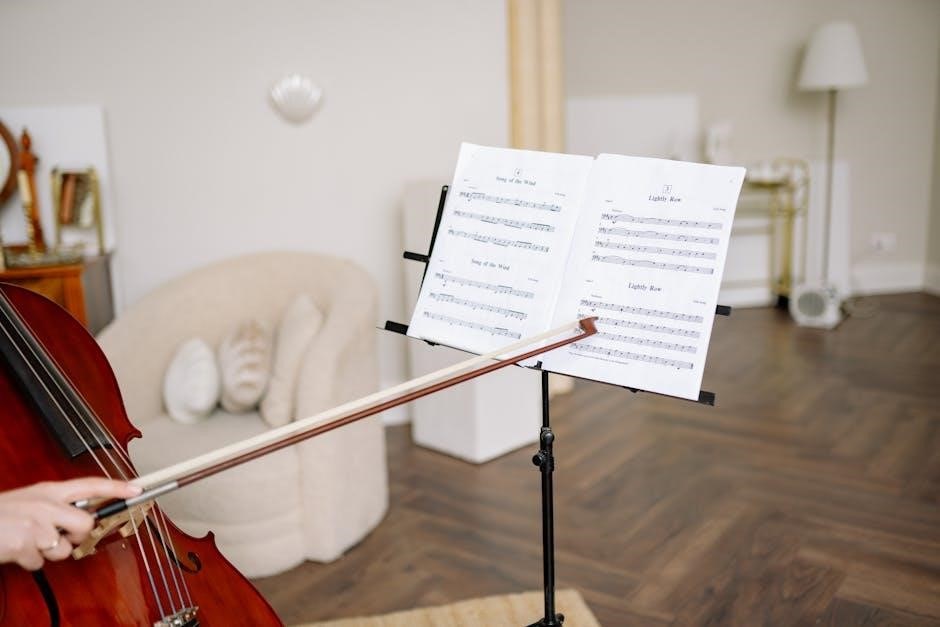The Suzuki Method is a renowned educational approach emphasizing early talent development through music. Founded by Shinichi Suzuki‚ it focuses on nurturing abilities through the “mother-tongue” technique‚ fostering musical growth and discipline in students worldwide.
1.1 Philosophy and History of the Suzuki Method
The Suzuki Method‚ developed by Shinichi Suzuki‚ is rooted in the belief that every child can learn music like their native language. This philosophy‚ known as “Talent Education‚” emphasizes nurturing ability through immersion and repetition. The method emerged in post-war Japan‚ aiming to foster discipline‚ creativity‚ and character through music. Over time‚ it evolved into a global movement‚ adapting to various instruments‚ including the cello‚ and remains a cornerstone of music education worldwide.
1.2 Importance of the Suzuki Cello School
The Suzuki Cello School is a cornerstone of music education‚ offering a structured approach to learning. Its emphasis on early training‚ parental involvement‚ and the “mother-tongue” method fosters technical mastery and musical expression. The method’s focus on repetition and review ensures a strong foundation‚ while its inclusive philosophy makes it accessible to students of all backgrounds. The cello school’s global popularity underscores its effectiveness in nurturing musicians and instilling a lifelong love for music‚ making it a vital part of modern musical education.

Overview of Suzuki Cello Book 2
Suzuki Cello Book 2 is a continuation of the foundational skills introduced in Book 1‚ offering a progression of repertoire and technical challenges. It builds on earlier concepts‚ introducing more complex pieces while reinforcing proper technique and musicality. The book serves as a bridge to intermediate-level cello playing‚ providing a structured path for young learners to refine their abilities and deepen their understanding of music.
2.1 Structure and Content of Book 2
Suzuki Cello Book 2 is structured to build on foundational skills from Book 1‚ introducing more complex pieces and technical challenges. The book includes a variety of works such as Minuets‚ études‚ and folk songs‚ designed to enhance technique and musicality. Harmony parts and piano accompaniments are provided to enrich the learning experience. The content focuses on refining intonation‚ bow control‚ and finger dexterity while fostering expressive playing. Each piece is carefully selected to promote progression‚ ensuring students develop a strong musical foundation and prepares them for advancing to higher levels of cello study.
2.2 Purpose and Goals of Volume 2
The primary purpose of Suzuki Cello Book 2 is to further develop technical and musical skills‚ building upon the foundation established in Book 1. It aims to refine intonation‚ bow control‚ and finger placement while introducing more complex rhythms and dynamics. The goal is to enhance the student’s ability to play with precision and expression‚ fostering both confidence and a deeper appreciation for music. Volume 2 also prepares students for the challenges of subsequent books by strengthening their technical proficiency and musical understanding.
2.3 Transition from Book 1 to Book 2
The transition from Book 1 to Book 2 in the Suzuki Cello School marks a gradual progression in technical and musical complexity. Students move from foundational pieces to more intricate works‚ refining their skills in bowing‚ intonation‚ and finger placement. The shift introduces slightly advanced techniques and expands musical expression‚ ensuring a smooth evolution in the learner’s ability. This step builds confidence and prepares students for the more challenging repertoire in subsequent volumes‚ reinforcing the Suzuki Method’s emphasis on incremental growth and mastery through repetition and review;
Key Pieces in Suzuki Cello Book 2
Suzuki Cello Book 2 features pieces like Bach’s Minuet in G and Lully’s Gavotte‚ introducing more complex techniques while refining musicality and technical precision in young cellists.
3.1 List of Compositions and Their Significance
Suzuki Cello Book 2 includes Bach’s Minuet in G‚ Lully’s Gavotte‚ and other Baroque pieces‚ introducing students to more complex rhythms and bowing techniques. These compositions are carefully selected to build technical proficiency while fostering musical expression. The pieces are arranged to progress logically‚ reinforcing previous skills and introducing new challenges. They also expose students to the richness of classical music‚ helping them develop a deeper appreciation for historical styles. Each composition plays a vital role in the Suzuki curriculum‚ ensuring a well-rounded musical education for young cellists.
3.2 Analysis of Technical and Musical Challenges
Suzuki Cello Book 2 presents technical challenges like more complex bowing patterns‚ dynamic contrasts‚ and double stops. Musically‚ students must master phrasing‚ articulation‚ and expression. Pieces require precise intonation and rhythmic accuracy. The transition to higher positions on the cello introduces new fingerings‚ demanding greater dexterity. These challenges help students develop tone quality and refine their overall technique. The book’s progression ensures a balanced approach‚ fostering both technical proficiency and musical sensitivity‚ essential for advancing cellists.
3.3 Popular Pieces and Their Cultural Relevance
Suzuki Cello Book 2 features pieces like Minuets and Humoresque‚ which showcase diverse musical styles. These works introduce students to classical and folk traditions‚ enriching their cultural understanding. The Minuets‚ originally by Bach‚ highlight Baroque elegance‚ while Humoresque reflects Romantic-era expressiveness. Such pieces connect students to historical contexts and global musical heritage‚ fostering appreciation for the cello’s role in various cultures. This exposure enhances their musical journey and deepens their connection to the art form.

Techniques and Skills Developed in Book 2
Suzuki Cello Book 2 enhances bowing techniques‚ intonation accuracy‚ and complex fingerings. It introduces ensemble playing and advanced positions‚ building on skills from Book 1 for refined cello mastery.
4.1 Bowing Techniques and Variations
Suzuki Cello Book 2 expands bowing techniques‚ introducing legato‚ staccato‚ and spiccato. These variations enhance tone production and phrasing‚ with pieces like Minuet in G and Humoresque showcasing nuanced bow strokes. The book emphasizes dynamics and articulation‚ refining the student’s ability to express musicality. Through repetitive practice‚ students master bow control‚ fostering a polished sound and technical precision. This structured approach aligns with the Suzuki Method’s philosophy of early‚ consistent skill development‚ preparing cellists for more advanced repertoire in subsequent volumes.
4.2 Intonation and Tone Production
Suzuki Cello Book 2 places a strong emphasis on developing accurate intonation and rich tone production. Through carefully selected pieces‚ students refine their ability to produce clear‚ resonant notes. Exercises and repertoire‚ such as Minuet in G and Humoresque‚ help cultivate pitch accuracy and expressive phrasing. The method encourages consistent practice to build a strong‚ consistent tone‚ which is essential for advancing in cello studies. By focusing on proper bow placement and string contact‚ students develop the foundational skills needed for nuanced musical expression.
Suzuki Cello Book 2 introduces students to more intricate fingerings‚ expanding their technical proficiency. Pieces like Minuet in G and Humoresque require precise finger placement and dexterity; These exercises enhance finger independence‚ shifting‚ and accuracy. Students learn to navigate higher positions and complex patterns‚ preparing them for advanced repertoire. The methodical approach ensures a smooth transition to more demanding techniques‚ fostering confidence and mastery of the cello’s fingerboard. This foundational skill development is crucial for progressing to higher-level pieces in subsequent books.

Piano Accompaniment in Book 2
The piano accompaniment in Suzuki Cello Book 2 provides harmonic support and rhythmic guidance‚ enriching the learning experience. PDF versions are available for convenient practice and performance.
5.1 Role of the Piano in Suzuki Method
The piano accompaniment plays a vital role in the Suzuki Method‚ providing harmonic and rhythmic support. It enhances the learning process by offering a rich musical context‚ making practice engaging. The piano part is carefully designed to complement the cello pieces‚ fostering ensemble skills and musicality. In Book 2‚ the accompaniment is more complex‚ challenging students to refine their intonation and timing. PDF versions of the piano scores are widely available‚ ensuring accessibility for teachers and students. This collaborative approach strengthens the bond between the cello and piano‚ creating a cohesive musical experience that aligns with Suzuki’s philosophy of nurturing talent through environment and repetition.
5.2 Harmonization and Ensemble Playing
Harmonization in Suzuki Cello Book 2 enhances musical depth through carefully crafted piano accompaniments. These harmonies enrich the cello’s melody‚ promoting a cohesive ensemble sound. Ensemble playing is a cornerstone of the Suzuki Method‚ fostering collaboration and timing. The interplay between cello and piano in Book 2 helps students refine intonation and rhythmic accuracy. PDF versions of the accompaniments are widely available‚ ensuring accessibility for practice and performance. This harmonious dialogue between instruments aligns with Suzuki’s emphasis on creating a nurturing musical environment that encourages artistic expression and technical growth.

Practicing Suzuki Cello Book 2
Effective practice with Suzuki Cello Book 2 involves consistent review of PDF materials and companion recordings. Regular repetition and focused exercises ensure steady progress and mastery of techniques.
6.1 Tips for Effective Practice
Effective practice with Suzuki Cello Book 2 involves setting achievable goals and breaking pieces into manageable sections. Use a metronome to improve timing and intonation. Practice scales and arpeggios to build technique. Listen to recordings to internalize musicality. Focus on proper posture and bow control. Incorporate slow‚ deliberate practice to refine challenging passages. Regularly review past pieces to maintain familiarity. Seek feedback from teachers to address areas for improvement. Consistency and patience are key to mastering the repertoire in Book 2.
6.2 Importance of Repetition and Review
Repetition and review are cornerstone principles in the Suzuki Method‚ particularly for Cello Book 2. Regularly revisiting pieces strengthens technical skills and reinforces musical understanding. This approach ensures that students internalize nuances like intonation and articulation. Repetition builds confidence and fluency‚ while review prevents the forgetting of earlier material. By consistently practicing and reviewing‚ students develop a solid foundation for advancing to more complex repertoire in subsequent books. This methodical process fosters long-term mastery and a deep appreciation for music.
The Role of the Teacher
The teacher provides personalized guidance‚ corrects technique‚ and fosters musical expression. They inspire confidence and creativity‚ ensuring students progress effectively through Suzuki Cello Book 2.
7.1 Guidance and Feedback in Learning
In the Suzuki Method‚ teachers offer tailored guidance and constructive feedback‚ ensuring students master techniques in Book 2. They emphasize proper posture‚ bowing‚ and finger placement‚ while fostering musicality. Regular feedback helps students refine their skills‚ build confidence‚ and develop a deeper understanding of the pieces. This personalized approach ensures steady progress and prepares students for more complex repertoire in subsequent volumes.
7.2 Encouraging Musicality and Expression
Teachers in the Suzuki Method inspire students to connect emotionally with music‚ fostering musicality and expression in Book 2. Through phrasing‚ dynamics‚ and tone‚ students learn to convey the composer’s intent. The method emphasizes listening to recordings to internalize musical style and nuance. Teachers guide students to explore expressive variations‚ ensuring a rich‚ engaging sound. This approach nurtures a lifelong appreciation for music and develops the ability to communicate through performance‚ making learning meaningful and enjoyable for young cellists.

Advanced Concepts in Book 2
Book 2 introduces advanced techniques‚ including higher positions‚ varied dynamics‚ and intricate articulations. These elements challenge students to refine their skills and musical expression effectively.
Book 2 introduces higher positions on the cello‚ expanding the student’s technical range. These advanced positions‚ such as second and third‚ require precise intonation and finger placement. Students learn to navigate the fingerboard more confidently‚ enhancing their ability to play complex melodies. Proper posture and hand positioning are emphasized to ensure ease of play. This progression builds upon foundational skills‚ preparing students for more demanding repertoire in future volumes. The inclusion of harmony parts further enriches the learning experience‚ fostering ensemble awareness and musical depth. Regular practice and teacher guidance are essential for mastering these advanced techniques effectively.
8.2 Dynamics and Articulation
Dynamics and articulation are key elements in Book 2‚ adding depth and expression to the music. Students explore variations in volume‚ such as crescendo and decrescendo‚ and learn to interpret legato and staccato markings. These techniques enhance musicality and require precise control. The accompaniment supports these elements‚ providing harmonic context for dynamic contrasts. Mastery of dynamics and articulation helps students convey emotion and refine their technical skills‚ preparing them for more advanced repertoire in subsequent volumes while fostering a deeper connection to the music.
History and Development of Suzuki Cello School
The Suzuki Cello School was created by Shinichi Suzuki‚ expanding his violin method to cello. It emphasizes early learning and musical nurturing‚ fostering global growth in cello education.
9.1 Shinichi Suzuki and His Vision
Shinichi Suzuki‚ a visionary Japanese violinist‚ developed the Suzuki Method in the mid-20th century. His philosophy‚ ” Talent Education‚” aimed to nurture musical ability through early education. Suzuki believed that every child could learn music like their native language‚ emphasizing environment‚ repetition‚ and parental involvement. This approach led to creating the Suzuki Cello School‚ adapting his method for cello students. His vision transformed music education globally‚ fostering a love for music and technical excellence in young musicians‚ as seen in resources like the Suzuki Cello Book 2 PDF‚ which continues his legacy.
9.2 Evolution of the Cello Method
The Suzuki Cello Method has evolved significantly since its inception‚ adapting to meet the needs of diverse learners. Initially developed for violin‚ it expanded to include cello‚ with adjustments for the instrument’s unique characteristics. Over the years‚ the method incorporated feedback from teachers and students‚ leading to revised editions and supplementary materials. The development of resources like the Suzuki Cello Book 2 PDF reflects this evolution‚ providing accessible and comprehensive learning tools that align with Suzuki’s original vision of making high-quality music education accessible to all.

Resources and Materials
Accessible resources include Suzuki Cello Book 2 PDF downloads and digital versions‚ offering convenient access. Companion recordings provide auditory guidance‚ enhancing practice and understanding of the material effectively.
10.1 PDF Downloads and Digital Versions
Suzuki Cello Book 2 PDF downloads are widely available‚ offering students and teachers convenient access to the cello part and piano accompaniment. Digital versions provide interactive sheet music‚ enabling users to practice effectively. Resources like Suzuki Cello School Vol. 2 Cello Part and Piano Accompaniment PDFs are popular‚ with files ranging from 3MB to 17MB. These materials ensure easy access to the method’s teachings‚ supporting both individual and ensemble practices. Digital formats also allow for portability‚ making them ideal for modern learners seeking flexibility in their musical education journey.
10.2 Companion Recordings and Supplementary Materials
Companion recordings for Suzuki Cello Book 2 are essential for effective practice‚ providing high-quality audio to guide students. These recordings include both cello solos and piano accompaniments‚ helping learners develop accurate intonation and rhythm. Supplementary materials‚ such as harmony parts and ensemble scores‚ enhance the learning experience. Resources like Suzuki Cello School Volume 2 Cello Part and Piano Accompaniment PDFs are widely available‚ offering comprehensive support. These materials ensure a well-rounded education‚ aligning with the method’s emphasis on musical excellence and accessibility for students of all levels.

Benefits for Young Students
The Suzuki Method nurtures young students’ musical talents through structured learning and encouragement. Suzuki Cello Book 2 fosters technical growth and a deep appreciation for music‚ inspiring lifelong passion and skill development in cello playing.
11.1 Building Confidence and Skill
The Suzuki Method‚ particularly through Suzuki Cello Book 2‚ helps young students build confidence by mastering intermediate-level pieces. The structured progression of exercises and songs allows students to develop technical proficiency gradually. As they achieve each milestone‚ their self-assurance grows‚ fostering a sense of accomplishment. The method emphasizes repetition and review‚ ensuring a strong foundation in intonation‚ bowing‚ and finger placement. This consistent improvement not only enhances musical ability but also instills discipline and perseverance‚ preparing students for more advanced challenges in future volumes. The supportive learning environment further encourages creativity and passion for music.
11.2 Encouraging a Love for Music
The Suzuki Method‚ as reflected in Suzuki Cello Book 2‚ nurtures a deep appreciation for music in young students. By engaging with beautiful‚ culturally rich compositions‚ students develop an emotional connection to their instrument. The method’s emphasis on ensemble playing and accompaniment fosters collaboration and joy in musical expression. Parents and teachers play a crucial role in creating a supportive environment‚ encouraging students to explore and appreciate the artistry of music. This love for music often extends beyond lessons‚ becoming a lifelong passion that enriches their personal and cultural experiences. The method’s holistic approach ensures that music becomes a cherished part of their lives.

Comparison with Other Suzuki Books
Suzuki Cello Book 2 builds on the foundation established in Book 1‚ introducing more complex pieces and techniques while maintaining the method’s core philosophy of nurturing musical growth through structured progression. Unlike earlier volumes‚ Book 2 emphasizes deeper musical expression and technical challenges‚ preparing students for advanced studies in subsequent books. This progression reflects the method’s incremental approach to learning‚ ensuring a smooth transition to higher-level repertoire. The book’s content is tailored to refine skills introduced in earlier volumes‚ solidifying the student’s musical foundation. This sequential development is a hallmark of the Suzuki Method‚ ensuring comprehensive musical education. By comparing Book 2 with other volumes‚ students and teachers can better understand its role in the overall curriculum and how it contributes to long-term musical development. The structured progression from Book 1 to Book 2 and beyond highlights the method’s emphasis on gradual mastery and artistic growth. Each book in the series is designed to build on the previous one‚ fostering both technical proficiency and musical artistry. This comparative approach helps students appreciate the logical progression of the method and how each volume contributes to their overall musical journey. The availability of PDF versions of Suzuki Cello Book 2 and other volumes further enhances accessibility‚ allowing students to engage with the material in a convenient and modern format. Through this comparison‚ the value of Book 2 as a transitional and developmental tool in the Suzuki curriculum becomes evident‚ making it an essential resource for cellists progressing through the method. The method’s holistic approach ensures that each book‚ including Book 2‚ plays a vital role in the student’s musical education‚ providing a balanced blend of technique‚ repertoire‚ and musical understanding. By studying Suzuki Cello Book 2 in the context of the entire series‚ students can fully realize the method’s potential in fostering a lifelong love for music and a high level of artistic achievement.
12.1 Differences from Book 1
Suzuki Cello Book 2 introduces more advanced techniques and complex pieces compared to Book 1‚ focusing on refining skills and expanding musical expression. While Book 1 establishes foundational techniques‚ Book 2 builds on these with variations in bowing‚ fingerings‚ and dynamics. The repertoire in Book 2 includes pieces like Minuet in G by J.S. Bach and O Come‚ Little Children‚ showcasing a shift toward more intricate melodies and harmonies. Additionally‚ Book 2 emphasizes ensemble playing and harmonic understanding‚ with piano accompaniment playing a larger role. The structured progression ensures students are well-prepared for the challenges ahead‚ making Book 2 a critical step in the Suzuki Method curriculum.
12.2 Preparing for Book 3
Suzuki Cello Book 2 serves as a transitional phase‚ equipping students with advanced skills necessary for Book 3. It focuses on refining bowing techniques‚ such as spiccato and legato‚ and introduces more complex fingerings. Students also develop greater control over dynamics and articulation. The repertoire in Book 2‚ including pieces like Minuet in G and O Come‚ Little Children‚ emphasizes harmonic understanding and ensemble playing. Mastery of these elements ensures a smooth progression to Book 3‚ where higher positions and more intricate techniques are introduced. Consistent practice and review are essential for building the foundation needed for the challenges ahead.

Cultural Impact of Suzuki Method
The Suzuki Method has profoundly influenced global music education‚ fostering cultural exchange and nurturing musicians worldwide; Its emphasis on early learning and ensemble playing has popularized classical music across diverse communities‚ making it a cornerstone of modern cello education.
13.1 Global Popularity and Recognition
The Suzuki Method has gained worldwide acclaim for its innovative approach to music education. Widely adopted across continents‚ it has become a standard in cello instruction‚ with resources like the Suzuki Cello School Vol. 2 PDF being accessed by thousands globally. Its emphasis on early learning and ensemble playing has made it a preferred choice for educators and students alike‚ fostering a love for music and cultural exchange. The method’s popularity is evident in its extensive digital presence‚ including downloadable materials and interactive sheet music.
13.2 Influence on Cello Education Worldwide
The Suzuki Method has revolutionized cello education globally‚ setting a new standard for early musical training. Its structured approach‚ as seen in resources like the Suzuki Cello School Vol. 2 PDF‚ has inspired educators worldwide to adopt its principles. The method’s emphasis on accessible learning materials‚ including digital versions and piano accompaniments‚ has made high-quality cello education reachable for students of all backgrounds. This accessibility has fostered a unified approach to teaching‚ connecting students and educators across cultures and continents‚ while promoting a deeper appreciation for classical music.
The Suzuki Method’s effectiveness in nurturing young musicians is evident‚ with Suzuki Cello Book 2 playing a pivotal role in building confidence and skill‚ leaving a lasting impact on music education worldwide.
14.1 Summary of Key Points
Suzuki Cello Book 2 is a cornerstone in the Suzuki Method‚ offering a structured curriculum that enhances technical and musical abilities. It builds on foundational skills from Book 1‚ introducing more complex pieces and techniques. The book emphasizes proper intonation‚ bowing variations‚ and finger dexterity‚ while fostering musical expression. Resources like PDF downloads and piano accompaniments support learning. Teachers play a crucial role in guiding students through the material‚ ensuring a nurturing and effective educational experience. This volume is essential for progressing cellists‚ solidifying their musical foundation and preparing them for advanced studies.
14.2 Final Thoughts on the Value of Book 2
Suzuki Cello Book 2 is a vital resource for cellists‚ bridging foundational skills with advanced techniques. It enriches musical understanding‚ refines intonation‚ and enhances expressive playing. The structured curriculum‚ supported by piano accompaniments‚ fosters discipline and artistry. As a cornerstone of the Suzuki Method‚ it prepares students for higher-level repertoire while nurturing a lifelong passion for music. Its comprehensive approach ensures a solid technical and musical foundation‚ making it indispensable for aspiring cellists.
